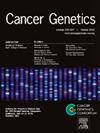NB-4细胞系标记染色体上MYC、PVT1和CCDC26基因扩增的Hi-C分析
IF 2.1
4区 医学
Q4 GENETICS & HEREDITY
引用次数: 0
摘要
MYC原癌基因可能在急性髓性白血病(AML)中异位扩增,表现为染色体外DNA (ecDNA),如双分钟(dmins)。然而,MYC扩增的机制和位置尚未完全阐明。为了表征NB-4细胞中MYC的位置及其周围结构,我们使用原位高通量染色体构象捕获(in situ Hi-C)进行了这项研究。NB-4细胞株进行Hi-C分析。采用全基因组测序(WGS)和荧光原位杂交(FISH)进行验证。Hi-C在8q24.21区域发现了涉及PVT1和CCDC26的倒置和涉及MYC、PVT1和CCDC26的扩增片段。MYC、PVT1和CCDC26不仅在8号染色体上发现,而且在核内的某些地方也发现,而不是在8号染色体上。核型分析显示只有两条正常染色体8,其他染色体缺失或异常。FISH发现MYC、PVT1和CCDC26存在于两条正常染色体8和多条标记染色体上。我们的研究结果表明,8号染色体的数量和结构异常先于MYC扩增和移动。MYC可能具有不仅移动到dmins的特性,而且由于未知但确定的原因也移动到其他染色体,如标记染色体。MYC异位扩增不仅是实体瘤的现象,也是AML的复发现象。此外,在更广泛的意义上,异位扩增是异常癌基因的一种形式。我们提出Hi-C作为这种现象的筛选方法。我们将在多个AML细胞系和患者样本的不同阶段进一步验证这一现象。本文章由计算机程序翻译,如有差异,请以英文原文为准。
Hi-C analysis of amplification of MYC, PVT1, and CCDC26 on marker chromosomes in the NB-4 cell line
MYC proto-oncogene may be amplified ectopically in acute myeloid leukemia (AML) as extrachromosomal DNA (ecDNA) such as double minutes (dmins). However, the mechanism and location of MYC amplification have not been fully elucidated. To characterize the location of MYC and its surrounding structure in NB-4 cells, we conducted this study using in situ high-throughput chromosomal conformation capture (in situ Hi-C). Hi-C analysis was performed in NB-4 cell line. Whole genome sequencing (WGS) and fluorescence in situ hybridization (FISH) were used for confirmation. Hi-C revealed an inversion involving PVT1 and CCDC26 and amplified segments involving MYC, PVT1, and CCDC26 on 8q24.21 region. MYC, PVT1, and CCDC26 were found not only on chromosome 8, but also somewhere intranuclear, other than on chromosome 8. Karyotyping revealed only two normal chromosomes 8, and the others were missing or abnormal. FISH revealed the presence of MYC, PVT1, and CCDC26 on the two normal chromosomes 8 and multiple marker chromosomes. Our results suggest that the numerical and structural abnormalities of chromosome 8 precede MYC amplification and moving. MYC may have properties that move not only to dmins, but also to other chromosomes such as marker chromosomes for unknown but certain reasons. MYC ectopic amplification is not only a phenomenon in solid tumors, but also a recurrent phenomenon in AML. Furthermore, in a broader sense, ectopic amplification is a form of abnormal oncogenes. We propose Hi-C as a screening method for this phenomenon. We will further verify this phenomenon in various phases of multiple AML cell lines and patient samples.
求助全文
通过发布文献求助,成功后即可免费获取论文全文。
去求助
来源期刊

Cancer Genetics
ONCOLOGY-GENETICS & HEREDITY
CiteScore
3.20
自引率
5.30%
发文量
167
审稿时长
27 days
期刊介绍:
The aim of Cancer Genetics is to publish high quality scientific papers on the cellular, genetic and molecular aspects of cancer, including cancer predisposition and clinical diagnostic applications. Specific areas of interest include descriptions of new chromosomal, molecular or epigenetic alterations in benign and malignant diseases; novel laboratory approaches for identification and characterization of chromosomal rearrangements or genomic alterations in cancer cells; correlation of genetic changes with pathology and clinical presentation; and the molecular genetics of cancer predisposition. To reach a basic science and clinical multidisciplinary audience, we welcome original full-length articles, reviews, meeting summaries, brief reports, and letters to the editor.
 求助内容:
求助内容: 应助结果提醒方式:
应助结果提醒方式:


